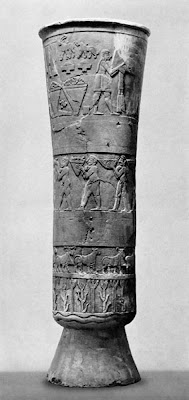Sumerian Art: The Stele of the Vultures
"Partially reconstructed from numerous fragments found among the remains of the Sumerian city of Girsu, this victory stele, known as the "Stele of the Vultures," is the oldest known historiographic document. A long Sumerian inscription narrates the recurrent conflict between the neighboring city-states of Lagash and Umma, and records the victory won by Eannatum, king of Lagash, who ruled around 2450 BC.The triumph of this ruler, placed under divine protection since his birth, is illustrated with a wealth of detail in the remarkable relief carving that adorns both sides of the stele. The so-called "historical" side shows Eannatum marching at the head of his troops, who advance in a tight phalanx, trampling over the dead bodies of the enemy. The lower registers show the victory parade, led by the ruler in his chariot, and then the funeral ceremonies that ended the military engagement. The other, "mythological" side is dominated by the majestic figure of Ningirsu, the protector god of the city-state of Lagash, who has the enemy troops entrapped in a gigantic net and strikes them with his mace. One side narrates the actions of men and the other the intervention of the god, in a thematic division that has symbolic importance: human determination and divine protection come together to ensure victory."
Source: LOUVRE

Stele of The Vultures
image source: I.Winter-"After the battle is over: The Stele of The Vultures and Historical Narrative"




Comments